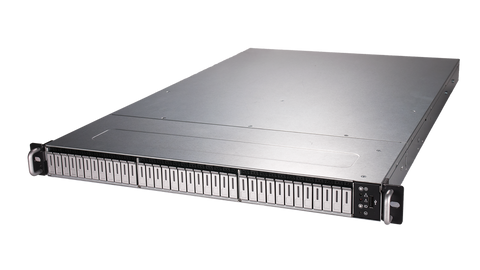How does Premio Storage Solutions fit in the different Stages of Post-Production and Content Creation?
As the craving for high definition (HD), 4K, and even 8K content exceeds actual expectation, the media and entertainment industry will also continue to explode with a digital transformation across all its technology drivers. Everything from camera technology to content delivery and streaming are being shaped by consumer demands for better quality and accessibility. Most of all workflows for content creation are digital and require enormous amounts of storage hardware options that deliver real-time performance.
Learn more about how Premio storage solutions solve storage complications in the post-production workflow below; Or come see high-performance storage solutions at NAB Booth # SL12208

Diagram and Image Credit: https://www.backblaze.com/
Traditionally the key challenge for content production was to efficiently archive, organize, but most importantly have access to uncompressed files during critical stages in the file processing pipeline and throughout the entire post-production workflow. This process was often the most challenging and even today still requires a massive well-managed centralized storage infrastructure. Especially when it comes to storage solutions for the media & entertainment industry, a main goal is to have the ability to use high-performance storage tiers with the latest storage technologies to deliver performance and real-time efficiency that can be shared. Some of the most common storage solutions that are accessible through different level of raid-arrays (0/5/6/10) that either sit locally on a HDD/SDD, in direct attached storage (DAS), or centralized storage also known as a “storage area network” (SAN). The SAN infrastructure relies on utilizing a high-speed connection that can be accessed by multiple sources or editors for real-time collaboration. Currently major post-production studios use a storage area network (SAN) to allow for multi-level access and organization of its media files for creation. Premio Innovative Solutions offers purposely-built storage solution tiers that allow production studios to organize, archive/backup, and have seamless access to files for real-time editing and interpretation.
Step 1: Ingest and transfer from capture media
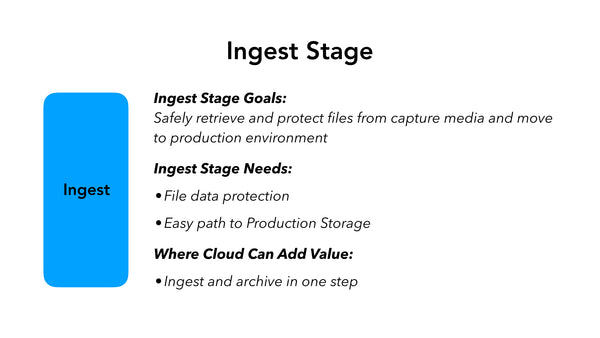
Diagram and Image Credit: https://www.backblaze.com/
 Scope and Challenge:
Scope and Challenge:
Production studios are maximizing their ability to offload media files from high-performance cameras to mobile storage tiers directly in the field. This pre-production strategy allows for immediate playback and storage archives for any level of file-based acquisition; creating a streamlined ingestion of files for editing and enhancements. These mobile media management carts offer an on-set solution that is integrated with RAID6, Uninterruptible power supply (UPS) and an expander for maximum performance. Some of the features that are offered in these mobile on set carts are Real-time RAW playback, Stereo, Dailies Prep, Transcoding, Color, and whatever production teams need.
Premio Ingest and on-set Storage Solutions:

Key Specifications:
- Dense 1PB storage for archival, backup and recovery object storage
- Single-tier SAS expander topology
- Dual node design for maximum High availability and mission critical redundancy
- Recommended Software Solution Stack:
RAIDIX 4.X for Media & Entertainment - RAIDIX 4.X is a powerful software base for storage systems to endure in environment of high load processes and demanding applications. It was especially designed for post-production and TV broadcast, where it proved outstanding results in terms of performance and data availability on common server hardware. Learn more about Radix 4.X for media & entertainment here: https://www.raidix.com/solutions/media/
“High Performance Software-Defined Storage for Media and Post-production”
Application Use Case:
In the ingest stage one of the major goals is to retrieve and transfer RAW uncompressed data into the production environment for editing. Since the organization and backup of the captured media files are absolutely critical for future post-production stages, it is important to leverage some type of redundancy within the on-set storage tier. The data and/or media files are protected in a storage tier by utilizing a dense storage server that offers multiple nodes for availability and data archival protection. The Premio 4U 48 High Availability Redundant Storage Server (DSS448S-D5) offers 1PB of available storage capacity with dual-node storage tiers and performance benchmarks of 10GB/s. The dual-node design is a key benefit of the solution for media and entertainment workloads because it guarantees data redundancy protection and before captured data is transferred into an editing post-production stage.
Archival Expansion Storage JBODS
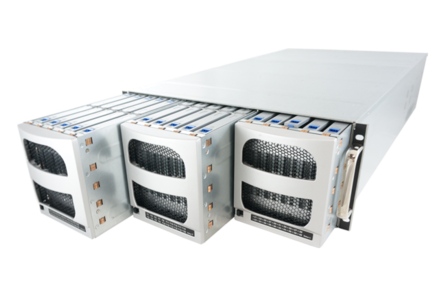
Key Specifications:
- 4U with 60x top-load 12G SAS patented tray-less hot-swap HDD bays
- Hot-swap redundant 12G Expanders up to 192Gbps per Expander
- 32” short depth with patented internal cable-management arm
- Ease of serviceability with 6 hotswap exhaust fans and Platinum grade HRP PSU
- Remote management GbE port for status report
Application Use Case:
Another key necessity in the ingest stage specifically tied to storage management is to have access to additional storage to offload captured media data files. A JBOD solution connected to a 12G/b SAS expander will allow for even more storage capacity and archival before transferring into a production environment. The Premio 4U 60Bay JBOD (eDrawer4060J-S3) is a perfect solution in a both on-set and/or SAN environment for storage expansion when additional storage is needed.
Step 2: Work-in-process and real-time editing
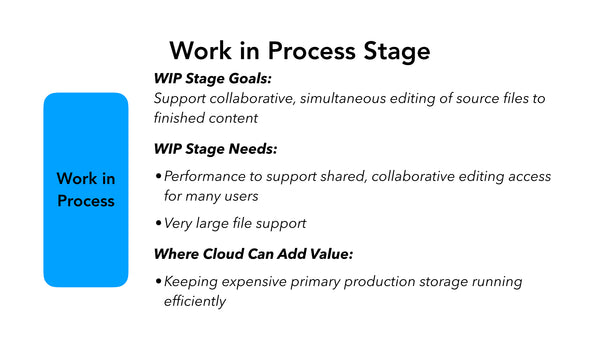
Diagram and Image Credit: https://www.backblaze.com/
Scope and Challenge:
After the 1st step of capturing and archiving data is complete from on-set filming, all the files need to be transferred into a production environment that requires collaborative real-time editing. Major studios and post-production experts usually manage the data through a high-speed SAN network to allow access for multiple editors in the workflow. Since most cinematography content and media files today are now being captured in digital HD, 4K and even 8K resolutions, this phase is extremely important from an accessibility and storage tier point of view.

The 2nd phase or the editing process of the production workflow is critical because it acts as the hub for raw video files. In this phase the storage organization, backup, assembly, audio/syncing, and editing of the raw files occur, requiring access to enormous amounts of data at high performance speeds; this is also known as the caching/editing tier for real-time edits. The main challenge from this storage tier is its ability to serve demanding workloads in HD,4K, and 8K video streams without latency delays. This challenge is addressed by utilizing a cached storage tier that is able to deliver media files with high-performance speeds that is often funneled through a high-speed centralized SAN network. Premio offers innovative storage architectures to deliver high-performance to support shared, collaborative editing access for post-production users.
Premio High Performance Storage Solutions for Collaborative Editing:

Key Specifications:
- Storage server supports Single Socket AMD EPYC CPU up to 2TB DDR4
- Capable of sustaining up to 250Gbps of bandwidth and 7.8 IOPS
- 1U with 20x hot-swappable 2.5”-7mm NVMe U.2 SSD bays
- Supports 3x PCIe3 x16 slots
- 80 Plus Platinum 500W Redundant PSU
Key Specifications:
- Storage server supports Single Socket AMD EPYC CPU up to 2TB DDR4
- Capable of sustaining up to 300Gbps of bandwidth and 7.8M IOPS
- 1U with 36x hot-swappable NF1 or M.2 NVMe SSD bays
- Supports 2x PCIe3 x16 slots and 1x PCIe3 x16 OCP 2.0 card
Key Specifications:
- All NVMe Flash Array supports Dual Intel® Xeon® SP Scalable Processors (Skylake)
- Support 12 x front accessible hot-swap NVMe PCIe3 x8 Add-in-Cards
- Up to 60GB/s (480 Gigabits/s) throughput and 12 Millions IOPS through RDMA
- Support 4x full height PCIe3 x16 and 2x Low Profile PCIe3 x16 slots
- Symmetrically balanced design, each CPU managing half NVMe and NIC
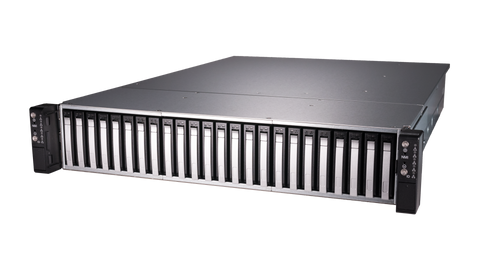
Key Specifications:
- Storage server supports Single AMD EPYC™ up to 1TB DDR4
- 2U Redundant High Availability dual systems (nodes)
- Supports high density 24 hot-swappable 2.5”-15mm NVMe U.2 SSD bays
- Supports redundancy heartbeat through optional GbE and PCIe x 16 NTB
Application Use Case:
A key goal in the editing stage is to provide stable, high-performance storage access for multiple users. EchoStreams is able to solve key storage challenges in the media and entertainment industry by providing innovative storage solutions for maximum performance throughout the entire media production workflow. Especially as new computing technologies offer powerful CPU cores and NVMe performance-based SSD hard drives, editors are able to craft and manipulate content from a cache tier not only in HD, 4K, and 8K workloads but in real time.
Both the FlacheSAN1N20U-UN and FlacheSAN1N36M-UN high performance NVMe storage servers act as the perfect cache-access for a collaborative storage tier due to its impressive throughput and IOPS; these storage servers are able to push 25~30 GB/s and over 7.8 million IOPS, providing access to blazing fast storage for workflow editing.
 In addition, the DuraStreams 2U 24 NVMe Dual-Node High Availability Storage Server (DSS224N-UN) is truly innovative in its class, acting as a hybrid for both for high performance based archival and cache-editing storage with redundancy in a single server. The DSS224N-UN offers NVMe performance speeds that are architected around a dual-node design, providing swift PCIe Gen 3 x16 redundant speeds over a non-transparent bridge. Both compute nodes can function in an active/active or active/passive modes to offer real-time editing access for next-gen workflow storage.
In addition, the DuraStreams 2U 24 NVMe Dual-Node High Availability Storage Server (DSS224N-UN) is truly innovative in its class, acting as a hybrid for both for high performance based archival and cache-editing storage with redundancy in a single server. The DSS224N-UN offers NVMe performance speeds that are architected around a dual-node design, providing swift PCIe Gen 3 x16 redundant speeds over a non-transparent bridge. Both compute nodes can function in an active/active or active/passive modes to offer real-time editing access for next-gen workflow storage.
- Recommended Storage Server Software Solutions Stack:
RAIDIX 4.X for Media & Entertainment - RAIDIX 4.X is a powerful software base for storage systems to endure in environment of high load processes and demanding applications. It was especially designed for post-production and TV broadcast, where it proved outstanding results in terms of performance and data availability on common server hardware. Learn more about Radix 4.X for media & entertainment here: https://www.raidix.com/solutions/media/
Step 3: Deliver
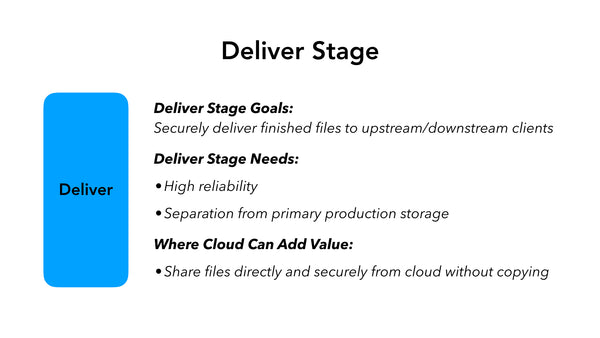
Diagram and Image Credit: https://www.backblaze.com/
Scope and Challenge:
All the hard work and editing of finished content should not be kept in the dark. On the contrary, finished media and entertainment should be accessible and reachable by the audience. The more people it reaches, the more it will be appreciated. However, after editing, the way content is delivered is of extreme importance. High quality media attracts a lot of attention; however, it is also heavy and requires efficient servers in order to deliver the content smoothly and with no, or minimal, interruptions. To provide an efficient Content Delivery Network (CDN), not only is the geographical position important, but also the performance and speed at which the servers can deliver the content. CDNs improve load times and reduces bandwidth costs depending on the technology. Flash servers, for instance, are best in this field of work since it provides data availability and performance with low latencies, delivering thousands, even millions, of IOPS. It is crucial to provide fast delivery with cache content at the network edge.
Premio High Performance Storage Solutions for Content Delivery Networks:

Key Specifications:
- Storage server supports Single Socket AMD EPYC CPU up to 2TB DDR4
- 1U with 36x hot-swappable NF1 or M.2 NVMe SSD bays
- Supports 2x PCIe3 x16 slots and 1x PCIe3 x16 OCP 2.0 card
- Capable of sustaining up to 300Gbps of bandwidth and 7.8M IOPS
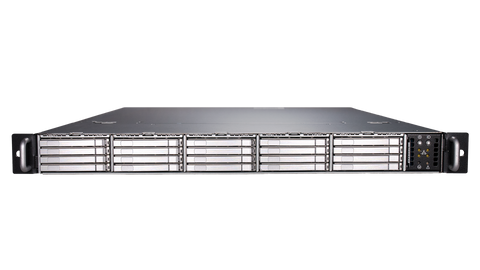
Key Specifications:
- Storage server supports Single Socket AMD EPYC CPU up to 2TB DDR4
- Capable of sustaining up to 250Gbps of bandwidth and 7.8 IOPS
- 1U with 20x hot-swappable 2.5”-7mm NVMe U.2 SSD bays
- Supports 3x PCIe3 x16 slots
- 80 Plus Platinum 500W Redundant PSU
Application Use Case:
To deliver the best customer experience, reliability and performance are key factors in a CDN. As of today, flash servers are the best option to deliver media and entertainment content. Thanks to its balanced architecture, our systems can reach speeds of up to 300 Gb/s (250Gb/s on the 1U 20 NVMe U.2 system). Both M.2 and U.2 Flash Servers transfer data through PCIe lanes at 8GT/s per lane (up to x4 lanes per drive), which can lead to extremely high speeds coming out from only one system. And, with today’s advancing pace, it is expected to increase the number of servers per data center, leading to even higher data transfer speeds in order to keep with customers’ needs.
Our flash servers are designed to work 24/7 and handle a vast amount of data. Although this may lead to more power consumption and heat production, our systems are equipped with 80 Plus Platinum redundant power supplies that maximize power consumption, reduce costs and minimize heat production.
Step 4: Archive
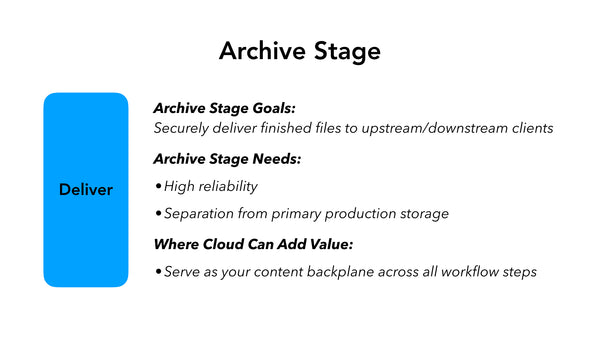
Diagram and Image Credit: https://www.backblaze.com/
Scope and Challenge:
The final step of the post-production workflow process is to archive content in a safe and reliable storage tier, segregated and away from the high-performance caching/editing production tier. Since real-time collaborative editing is no longer the main goal, the final content files need to be moved into a long-term reliable storage solution that is still scalable and balanced in terms of accessibility, performance, and cost. This particular storage tier is often higher in density and can support scalable storage capacities in petabyte capacities for archival and back-up. Traditionally most of the data files were transferred into tape media due to the cost/GB savings for archiving reliability; but as high capacity disk-based HDDs become more affordable, dense storage solutions over TCP/IP that can support iSCSI, or Fiber Channel protocols may be more beneficial for an archival repository.
Premio High Density Storage Solutions for Archive and Reliability:
- ScaleStreams 4U 48 High Density Storage Server
- eDrawer4048S-D5 (Intel) / eDrawer4048S-UN (AMD)

Key Specifications:
- Supports Single Socket AMD EPYC™ or Dual Socket INTEL Skylake
- up to 1TB -1.5TB DDR4 RAM
- Supports 48 x 3.5” and 4 x 2.5” hot-swap SSD/Hard Drives in 4RU
- Two 36 ports 12G SAS expanders for maximum throughput
- Supports full height PCIe expansions without risers
- ScaleStreams 4U 60 High Density Storage Server
- eDrawer4060S-D5 (Intel) / eDrawer4060S-UN (AMD)

Key Specifications:
- Supports Single Socket AMD EPYC™ or Dual Socket INTEL Skylake
- Support 60 x 3.5″ Trayless Drive Bays in 4RU
- Two 48 ports 12G SAS expanders for maximum throughput
- Support full height PCIe expansions without risers
As content is package and completed in a compressed format, one major goal in this step is to archive the media files into a repository of reliable storage. The archive storage tier requirements is different than a performance-driven caching tier and focuses more on the needs of higher density, scalability, and reliability of long-term storage. In addition, as the demand and speed of post-production workflows increase in scale, the media and entertainment industry requires reliable storage solutions to support archival/retrieval of content files.
ScaleStreams high density storage servers are a perfect solution to address the demands for post-production content archiving. The dense storage solutions can scale over 1PB in a single server and over 8PBs in a 42U rack, offering a super dense repository for media file storage. Another key benefit for all ScaleStreams products is the balance architecture for maximum throughout and performance, providing over 10GB/s per storage server.
- Recommended Storage Server Software Solutions Stack:
RAIDIX 4.X for Media & Entertainment - RAIDIX 4.X is a powerful software base for storage systems to endure in environment of high load processes and demanding applications. It was especially designed for post-production and TV broadcast, where it proved outstanding results in terms of performance and data availability on common server hardware. Learn more about Radix 4.X for media & entertainment here: https://www.raidix.com/solutions/media/





